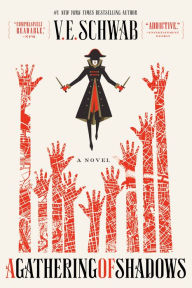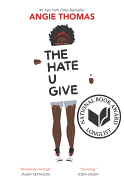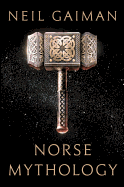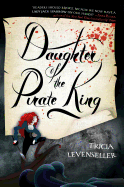Week of Tuesday, February 28, 2017
Successful trilogies are tricky. And fantasy trilogies? Even more so. Requirements include a robust world with just the right amount of imaginative detail to urge the reader on rather than too much, which leads to retreat. Living, breathing characters who beg to be explored. And a plot that doesn't sag in the middle or disappoint in the end. A tall order, to be sure. And V.E. Schwab, author of the Shades of Magic series, delivers with skillful, epic ease.
 Four alternate Londons (Red, Black, Grey, and White) exist in A Darker Shade of Magic (now in paperback from Tor). Kell, one of the last Travelers--magicians with the ability to travel between parallel universes--encounters accomplished thief Delilah Bard, whose desire to leave Grey London is as dire as Kell's need to escape the consequences of his smuggling side-job. Adventure beckons, and Schwab's smart, exhilarating story doesn't let go until the very end. And, not even then.
Four alternate Londons (Red, Black, Grey, and White) exist in A Darker Shade of Magic (now in paperback from Tor). Kell, one of the last Travelers--magicians with the ability to travel between parallel universes--encounters accomplished thief Delilah Bard, whose desire to leave Grey London is as dire as Kell's need to escape the consequences of his smuggling side-job. Adventure beckons, and Schwab's smart, exhilarating story doesn't let go until the very end. And, not even then.
 Set four months later, A Gathering of Shadows (Tor paperback) finds Kell learning to live magically bound to another, Delilah unleashing her talent for magic, and an international magical competition taking place. The nuanced world-building and agile characterization begun in book one continue here, proving an addictive concoction when paired with the innovative adventure.
Set four months later, A Gathering of Shadows (Tor paperback) finds Kell learning to live magically bound to another, Delilah unleashing her talent for magic, and an international magical competition taking place. The nuanced world-building and agile characterization begun in book one continue here, proving an addictive concoction when paired with the innovative adventure.
 The final book in the series, A Conjuring of Light (coming next month in hardcover from Tor) picks up mere minutes after the ending of book two, when the tenuous tie among the four Londons has reached a breaking point. Kell and Delilah are called upon to save the magic that's shaped their very lives. And while heeding the call comes naturally, the real question is, will they be able (and willing) to answer? Readers may wish for the quintessential happy ending. But Schwab writes the conclusion that each character needs--one that rings true while simultaneously breaking and mending your heart. --Stefanie Hargreaves, editor, Shelf Awareness for Readers
The final book in the series, A Conjuring of Light (coming next month in hardcover from Tor) picks up mere minutes after the ending of book two, when the tenuous tie among the four Londons has reached a breaking point. Kell and Delilah are called upon to save the magic that's shaped their very lives. And while heeding the call comes naturally, the real question is, will they be able (and willing) to answer? Readers may wish for the quintessential happy ending. But Schwab writes the conclusion that each character needs--one that rings true while simultaneously breaking and mending your heart. --Stefanie Hargreaves, editor, Shelf Awareness for Readers
Norse Mythology
by Neil Gaiman
"Do you wonder where poetry comes from," asks the narrator in the middle of Norse Mythology. "Where we get the songs we sing and the tales we tell...? It is a long story, and it does no credit to anyone: there is murder in it, and trickery, lies and foolishness, seduction and pursuit." Then, because the story predates the written word, a simple command: "Listen."
For newcomers and old fans, here are the classic stories of Odin, Thor and Loki, of Asgard and Midgard, of frost giants and dwarves, and of the greatest battle ever foretold, Ragnarök, recounted with clarity and utter glee.
Gaiman (The View from the Cheap Seats, Fortunately the Milk, The Ocean at the End of the Lane) is no stranger to myth. Since his Sandman comics, he has drawn from the world's folklore and fables to create his own brand of fantastic fiction. An unabashed storyteller, he re-creates the stories of Odin, Thor, Loki and their ilk into a linear, novelistic sequence in Norse Mythology. Or as sequential as they can be, given that gods have a habit of springing back to life even after they are gruesomely killed.
If the prose of Gaiman's earlier novels at times veers inconsistently between the dark and the silly, between workmanlike and ornate, here he perfects the balance. The voice is anchored by ancient oral texts, which in turn offer large enough gaps in detail for Gaiman to fill in with scene-work and his trademark wit. --Zak Nelson, writer and bookseller
Discover: Neil Gaiman's accessible, gleefully violent compendium of Norse myths features Odin, Thor and, most jubilantly, Loki the trickster.
Amiable with Big Teeth: A Newly Discovered Novel
by Claude McKay
Claude McKay (Home to Harlem) was one of the most significant Harlem Renaissance writers, and the first African American to have a bestselling novel in the U.S. He completed his ambitious satirical novel Amiable with Big Teeth: A Novel of the Love Affair Between the Communists and the Poor Black Sheep of Harlem under contract in 1941, but it was rejected and somehow vanished into the files of an independent publisher. It was rediscovered in 2012, and this is its first publication.
McKay drew heavily on his personal knowledge of the celebrities, artists and political figures of his time to create vivid characters with international connections and warring interests. Many of his themes and concerns are still all too relevant. He illustrates the problems of competing ideologies, style over substance, self-serving egos and ignorant good intentions. His complex and flamboyantly dramatic plot centers on the efforts of Harlem black nationalist intellectuals to rally support for Ethiopia after its invasion by Italy, and the attempt by Communists to hijack that movement. "What for? Not for our interest but for their interest.... When we resist them they try to put us on the spot, saying we believe in segregation. They use their superior white position to promote a lie against our vital interests and whitewash it to make it appear like truth." This is a rich, intimate, bitterly funny portrait of 1930s Harlem, the nightlife and street life, the social and political intrigue. --Sara Catterall
Discover: Lost for more than 70 years, this ambitious satire by a great early-20th century author is bitterly funny and relevant.
The Burning World
by Isaac Marion
Isaac Marion's rom-zom-com Warm Bodies won fame and acclaim with a successful film adaptation in 2013, leading Marion to expand his post-zombie-apocalyptic world in the prequel A New Hunger. In this long-awaited sequel, revived zombie R and his living girlfriend, Julie, face an increasingly complicated future.
Although the lovebirds have settled into a house in the ruined suburbs of the Pacific Northwest, Julie and R attend a meeting at the stadium where most of the area's humanity clusters, guarded by the remains of the military. Helicopters arrive bearing suited men from a corporation called Axiom, which promises modern solutions to today's problems, including "inhuman monsters who want to eat your family." Axiom wants to know the secret of R's recovery from zombiehood, something not even R understands, and tortures Julie for information. The couple is soon on the run with an Axiom defector and his six-year-old daughter, Sprout, as well as Julie's friend Nora. On a cross-country search for safe haven, R's memories of his pre-death life begin to plague him, particularly his connection to Axiom itself.
R's continued attempts to reclaim his humanity demonstrate that in his world the zombies have more individuality than the humans who make up Axiom's villainous corporate hive. Questions of individuality and morality underscore the zombies' treatment in a disquieting echo of the plight of underprivileged parts of society. Though familiarity with Warm Bodies helps, new readers can use this sequel as an entry point into this alive and kicking series. --Jaclyn Fulwood, blogger at Infinite Reads
Discover: This sequel to Warm Bodies delves into R's past as he faces a menacing new adversary.
Mystery & Thriller
A Darkness Absolute
by Kelley Armstrong
Kelley Armstrong's A Darkness Absolute opens with Detective Casey Duncan (City of the Lost) pursuing a resident in her adopted town of Rockton, a hideaway for people who don't want to be found. The runner has fled, in a blizzard, into the forbidden surrounding woods. Taking shelter until the storm blows over, Casey and sheriff's deputy Will Anders discover a woman who's been held prisoner in a cave for more than a year. Rescuing her, however, is just the beginning of a complex mystery.
The woman can identify her captor only by body type--he always wore a mask in her presence. To Casey's relief, both Dalton--Rockton's sheriff and Casey's lover--and Will are eliminated as suspects. But the perpetrator could be almost every other man in the vicinity, not just Rockton residents but also the people called hostiles who live in the woods. Then Casey and her colleagues find evidence indicating the woman wasn't the first abductee, only the first to survive. And Casey starts noticing signs of someone stalking her. Can she solve the case before becoming the next victim?
Armstrong sustains a paranoid atmosphere throughout, with Casey rarely certain about whom to trust, including the victim. Many of Rockton's residents have violent pasts, and the hostiles are even more disturbing. The town remains a claustrophobic setting that's merciless when Mother Nature unleashes her power, striking with blinding snow and absolute darkness. But Casey is tough, too, and thriller fans will be eager for another trip to Rockton. --Elyse Dinh-McCrillis, blogger at Pop Culture Nerd
Discover: Detective Casey Duncan tracks a possible serial killer in an off-the-grid town for fugitives.
Science Fiction & Fantasy
All Our Wrong Todays
by Elan Mastai
Debut novelist Elan Mastai's All Our Wrong Todays begins in an alternate present that feels very much like the future, thanks to an invention created on July 11, 1965, by the scientist Lionel Goettreider. His Engine somehow harnesses the rotation of the Earth to produce "unlimited, robust, absolutely clean energy." For Tom Barren, then, the most wildly optimistic dreams of 1950s pulp science fiction authors have been realized, and the "future" bears more than a passing resemblance to The Jetsons.
Which is not to say that Barren's life is perfect. Haunted by the death of his mother in a freak hovercar accident, Barren becomes a chrononaut for his father's experiments in time travel. The plan is to go back and witness the unveiling of the first Goettreider Engine. But through a tragic sequence of events, Barren finds himself accidentally disrupting the crucial test and preventing his own reality from ever being born. Barren is pulled back to the present--our present--which to his eyes resembles nothing less than a dystopia: "I'm in the same world you're in.... Dull, vapid, charmless, barely evolved from the 1965 I just left."
Mastai is clever and self-aware in how he mines Barren's outsider status for humor. All Our Wrong Todays, like Andy Weir's The Martian, manages to respect the reader's intelligence without overwhelming with scientific mumbo-jumbo. The humor helps--Barren's terrible mistake is followed by an entire chapter of a repeated four-letter word--as do the multiple love stories that form the heart and soul of the novel. It is a very human story about a chronic screw-up finding his place in a screwed-up world. --Hank Stephenson, bookseller, Flyleaf Books
Discover: All Our Wrong Todays is a funny time-travel romp.
Biography & Memoir
A Country Between: Making a Home Where Both Sides of Jerusalem Collide
by Stephanie Saldaña
After falling in love with a French novice monk in an isolated Syrian monastery, American writer Stephanie Saldaña moved with her new husband into a house that straddled the line between East and West Jerusalem. Struggling to settle into her fragile new marriage and her equally precarious life on Nablus Road, Saldaña soon became pregnant with her first child. Her second memoir, A Country Between, chronicles the luminous, fraught, deeply formative years of living on a divided road within a city and country ravaged by many wars.
Saldaña (The Bread of Angels) observes the passage of seasons both outside her windows and inside her marriage: her husband, Frédéric, is a constant mystery, and Saldaña writes about their relationship as "a walk to meet each other, day after day, a promise, a shy approaching." Similarly, she learns the rhythms and greetings of her neighbors, the bread vendor on their doorstep, the nuns next door, and the mosaic of languages and cultures in this unfamiliar neighborhood that feels like home. As she grapples with pregnancy, writing, the reality of armed conflict and the challenges of daily life in Jerusalem, Saldaña grows ever more determined to study "the art of standing in front of the terrible, and waiting, hoping, that, in time, the beautiful would appear."
Thoughtful, candid and achingly lovely, A Country Between celebrates the moments of beauty and truth that appear even--or especially--in broken and hard places, bringing light and healing in unexpected ways. --Katie Noah Gibson, blogger at Cakes, Tea and Dreams
Discover: Stephanie Saldaña's luminous second memoir chronicles her years living in a war-torn Jerusalem neighborhood while building a marriage and a family.
History
The Book Thieves: The Nazi Looting of Europe's Libraries and the Race to Return a Literary Inheritance
by Anders Rydell, transl. by Henning Koch
Ceremonial book burnings and the theft of precious art works are well-known elements of Nazi Germany's rampage through Europe. In The Book Thieves, Swedish journalist Anders Rydell tells the less familiar story of how two Nazi agencies--the intelligence wing of the Schutzstaffel (SS) under Heinrich Himmler and the Reichsleiter Rosenberg Taskforce headed by Alfred Rosenberg--competed to plunder Europe's libraries until the regime's fall in 1945.
The Nazis' motivation for the theft and dismemberment of libraries was different from that which inspired the looting of precious artworks from museums and private homes. The stolen books were intended to supply Nazi "research" libraries with the raw material for an intellectual war between Nazism and its enemies. Jewish libraries, public and private, were the primary targets, but the agencies also attacked those dedicated to Freemasonry, socialism and the occult. Plunder was followed by destruction. Collections were divided up among different research institutes and warehouses. Books that were not deemed valuable, whether for their rarity or for research, were often destroyed.
The Book Thieves is a quest. Rydell travels across Europe, visiting the remains of plundered libraries and the institutions that still hold many of the stolen books. He talks to librarians who are involved with the overwhelming task of identifying stolen books and their owners, those attempting to rebuild lost collections, and those who mourn the ones lost without a trace. In the process, he tells the story of how the collections were built and the heroic attempts to protect them, creating a vivid picture of lost communities and lost knowledge. --Pamela Toler, blogging at History in the Margins
Discover: The Nazi plan to rewrite history was built on a foundation of stolen books.
Philosophy
From Bacteria to Bach and Back: The Evolution of Minds
by Daniel C. Dennett
In From Bacteria to Bach and Back, philosopher Daniel C. Dennett (Consciousness Explained) uses a scientific approach to explore the evolutionary origins of human consciousness. Our minds tend to be difficult to study because they are so mind blowing--we are beings that are aware of ourselves and of everything we know, without necessarily knowing how. What could be the evolutionary benefit of such a complicated attribute?
Dennett incorporates modern science with ancient questions of human identity, and takes this trend to its natural conclusion. But it is one that couldn't (and didn't) exist before Darwin, the mapping of the human genome or the Internet: consciousness, Dennett says, is not for anything.
Natural selection was able to evolve the brain from amoebas to self-aware enigmas in much the same way computers repeat algorithms. A perfect system need not know its own purpose in order to achieve it. By putting forth a spectrum of scientific theories, from evolutionary biology to linguistics, Dennett illustrates that consciousness is not a survival mechanism but rather a random mutation of nature.
In one of his more elegant passages, he uses Alan Turing's early experiments in building computers as an allegory for how evolution gave humans such a complicated consciousness. Turing understood about computer code what natural selection understands about consciousness: "In order to be a perfect and beautiful computing machine, it is not requisite to know what arithmetic is." --Josh Potter
Discover: Philosopher Daniel C. Dennett uses a variety of scientific disciplines to explore the evolution of human consciousness.
Science
The Evolution Underground: Burrows, Bunkers, and the Marvelous Subterranean World Beneath Our Feet
by Anthony J. Martin
The story of evolution, as it is typically told, just scratches the surface. Life on earth--even the very earth itself--has been shaped in unseen ways, right under our noses. So says Anthony J. Martin, a paleontologist, geologist and ichnologist (one who studies the tracks, trails, burrows, nests and feces of living organisms) in The Evolution Underground. While some dinosaurs took to the skies, many species became expert burrowers. From trilobites and earthworms to spiky-tailed lizards and fairy penguins, the ground beneath our feet teems with life. And it should: burrowers survived the giant meteorite that vanquished much of the planet's life 66 million years ago, and it will be burrowers who survive the next apocalypse. Ask anyone with an underground bunker.
Martin (Dinosaurs Without Bones) writes with obvious glee and a humor that at times digs for the dad-jokes, but as a scholar he knows his stuff--many of the natural discoveries he describes are his own. As he recounts the natural histories of underground cities in Turkey, gopher tortoises (a keystone species whose tunnels shape entire ecosystems in the southeastern United States), ants and other awe-inspiring subterranean dwellers, Martin delivers something the casual reader will not expect: a real education in paleontology. The Evolution Underground is a fun book of surprising depth. --Zak Nelson, writer and bookseller
Discover: One of the world's foremost experts crafts humorous scientific essays on the astonishing history of subterranean evolution.
Performing Arts
Spoke: Images and Stories from the 1980s Washington, D.C. Punk Scene
by Scott Crawford
Punk rock is a complex genre to tackle, but music journalist and filmmaker Scott Crawford does so admirably in Spoke: Images and Stories from the 1980s Washington, D.C. Punk Scene. A companion to the author's documentary Salad Days, the collection of photos and stories nevertheless stands on its own in homage to the scene Crawford grew up in, offering detailed context, interviews and commentary.
He opens with punk stalwarts Bad Brains, founded in 1977, expounding on their influence with quotes from such music legends as Henry Rollins, Ian MacKaye, Thurston Moore and Dave Grohl. Countless punk icons feature throughout the catalogue of D.C. bands. MacKaye's projects--Teen Idles, Minor Threat and Fugazi--appear in detail as bands that stamped their identity onto American eardrums.
Crawford includes detailed introductions to many of the bands by rock writer Tim Stegall, whose summaries help put both the artists and their music in context. Photos, often shot by Jim Saah, explode with raw, visceral energy. Show posters and fliers offer additional windows into the community and era through pen and passion, relics of a perpetually evolving scene. Spoke is an ode to a particular time and place, but Crawford assures readers it's no "misty-eyed scrapbook" or mere nostalgia; instead, it's a forthright testament to a kaleidoscopic community. This is a rounded collection, with surprises on every page. Given its D.C. focus, Spoke may encapsulate a fairly narrow slice of punk, but it's a critical one--and it's a collection that rocks. --Katie Weed, freelance writer and reviewer
Discover: Photos and tales of punk legends from the Washington, D.C., scene fill this tribute to a particularly rich music landscape.
Children's & Young Adult
The Hate U Give
by Angie Thomas
Many 16-year-olds think nobody understands them, but Starr Carter is sure of it, because she's two people on purpose. During the school day, she's "Williamson Starr," one of a handful of black students at her suburban private school, "approachable" to her friends and her white boyfriend, Chris. When she goes home to Garden Heights, a predominantly black neighborhood her Williamson Prep friends see as "the ghetto," she's just "Big Mav's daughter who work in the store." Starr is well-practiced in keeping her worlds apart, but when she witnesses her childhood friend Khalil's murder, after a cop pulls them over for a broken taillight, the split becomes simultaneously more necessary and nearly impossible. As she processes her grief, Starr pretends at school that nothing is wrong, but privately agonizes over her responsibility to her community. Many have opinions on whether she should testify before a grand jury or tell her story to the media, but the decision, unjust and difficult as it is, is ultimately Starr's.
In her debut novel, Angie Thomas creates what might be one of the decade's most vivid voices in YA fiction. Readers who recognize the first half of rapper Tupac's acronym for THUG LIFE in the title of the book--The Hate U Give--will thrill to the representation of Starr's multiple worlds; those who aren't familiar with Tupac's oeuvre will learn more about his work, and much more besides. Though the appalling scenario depicted here is sadly familiar, Thomas's clear and honest writing moves beyond sound bites to represent the real people and communities behind the headlines. --Stephanie Anderson, assistant director for public services, Darien Library (Conn.)
Discover: This timely YA debut novel shares a heartbreaking teen perspective on Black Lives Matter and racial divides in contemporary American society.
Daughter of the Pirate King
by Tricia Levenseller
Tricia Levenseller's vivacious debut novel, the first in a duology, boasts stormy seas, sexy pirates, swordplay and a heroine who conquers all three with aplomb.
Although her father is the Pirate King, 17-year-old sea captain Alosa isn't a typical princess. After years of rigorous training under the king's tutelage, Alosa can fight, sail and scheme better than any man. When her father asks her to be captured by rival pirate Draxen so she can search his ship for a coveted treasure map, Alosa obliges, confident she'll be back with her own ship and crew in no time. Unfortunately, she doesn't anticipate having Draxen's brother and first mate Riden as her interrogator. His shrewd eyes see through her pretenses, and his handsome face and quick wits prove distracting in ways she hadn't expected. If Alosa can keep him from guessing the true reason she's on his ship, she might pull off the plan, but their growing attraction threatens her focus, and his loyalty to Draxen.
Levenseller captures all the adventure and chemistry of a classic pirate romance novel, but unlike the bodice rippers of old, this leading lady never plays the role of damsel in distress. Anti-heroine Alosa will light up readers' imaginations with her tough attitude, constant snark and remorseless adherence to her own moral code, but she lights up most in her verbal and physical spars with Riden. A rip-roaring high seas escapade with a tinge of fantasy, Daughter of the Pirate King will engage and enthrall its teen audience. --Jaclyn Fulwood, lead librarian at Del City Public Library, Okla.
Discover: In this swashbuckling YA debut, an enchanting and ruthless teen pirate princess falls for her enemy while trying to steal from his brother.
| the church of living dangerously |
|

















